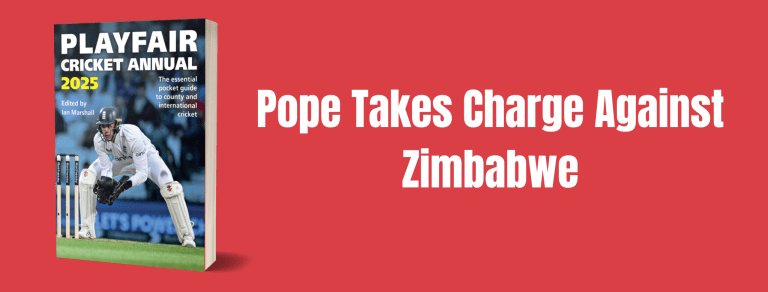Third Test v New Zealand 2022

For the final Test of the series, at Headingley, New Zealand made two changes to their team: Kane Williamson was back after his bout of Covid, replacing Matt Henry, while Neil Wagner came in for the injured Kyle Jamieson. the tourists looked light on bowling, and so it was to prove. For England, there was just one change, as James Anderson was suffering from an ankle injury, so Jamie Overton made his Test debut. The returning Williamson called the toss correctly and unsurprisingly chose to bat under clear, blue skies.
Tom Latham had suffered all series against Anderson, but this time it was Stuart Broad bowling the first over, and Latham pushed at one, edging it to Joe Root, and was out for a duck to give England the best possible start. There was an early sight of Jack Leach, and first ball Will Young was trapped in front to make it 35 for two. Then came the big wicket as Broad found Williamson’s edge to dismiss him for 31. Broad nearly picked up another when Devon Conway got a thickish inside edge but Ben Foakes couldn’t quite stretch far enough to hold on. It meant New Zealand got to lunch on 65 for three.
Early in the afternoon, Matty Potts was unlucky with an LBW shout against Conway, but it didn’t matter too much, as soon after Overton caught Conway’s inside edge and it clattered into the stumps. Things could have gone even better had they reviewed an LBW shout by Potts against the in-form Daryl Mitchell on 8, but surprisingly they chose not to against the tourists’ most in-form batter. Then came an extraordinary dismissal: Henry Nicholls drilled one from Leach straight back down the wicket, Mitchell took evasive action but the ball hit his bat and ballooned up to mid-off where Alex Lees took a simple catch: it was 123 for five at tea.
The evening session saw Mitchell joined by Tom Blundell, and this pairing had put on 195 together in the first Test and 236 in the second, so breaking them apart at any point before the close was bound to feel like a bonus to England. It didn’t happen and progress remained slow. Mitchell went to an almost inevitable fifty with a straight six off Leach, reaching the landmark in 100 balls. England took the new ball as soon as it was available, but it didn’t change their fortunes, as the partnership reached a hundred off 204 balls, before the day finished with the score on 225 for five.
England needed to take early wickets on Day Two, but first Blundell reached fifty in 111 balls (taking this partnership to 600 runs in the series at an average of 150). Then Mitchell edged Potts to Root, but Foakes dived across and dropped it. Finally Potts had a deserved wicket when he had Blundell LBW. England’s woes in the field continued when Bracewell was dropped in the slips by Jonny Bairstow off Broad – not the birthday present he was looking for as he turned 36.
England spent much of the morning complaining about the ball (rather a recurrent theme from both sides during this series) and eventually persuaded the umpire to change it. Second ball with the replacement and Broad found Bracewell’s edge and this time the catch was comfortably taken by Zak Crawley. When Mitchell went to 90, that meant he had beaten Martin Donnelly’s 1949 record of 462 runs for New Zealand in a series in England (achieved in four Tests) and he was closing in on a third century of the series. Meanwhile, Tim Southee swung away at a few, but it was a glorious straight six from Mitchell that took him to three figures, in 213 balls, becoming the first overseas player to score three Test centuries in a three-Test series in England. The fifty partnership came up in just 38 balls, and England looked in trouble, but in the last over before lunch Mitchell decided to launch one off Leach, but skied it to Stokes who took an excellent running catch. Out for 109, New Zealand went in at 325 for eight.
Early in the afternoon, Southee hit one even higher off Leach and Stokes again held on; two balls later Wagner hit another massive shot into the deep, and Bairstow took an excellent catch as the ball swirled in the air. It gave Leach his third five-wicket haul, and his first in England. New Zealand were all out for 329, and Leach had five for 100, having bowled with real control and skill throughout on a ground that isn’t traditionally that favourable to spin. He suddenly looked full of confidence – a great example of the new regime in action.
Initially New Zealand’s total looked daunting; Lees was beautifully bowled by Boult in the first over. Boult then beat Ollie Pope all ends up, finding a narrow gap between bat and pad, so Root was batting at 14 for two – just like the old days. Next, the Boult inswinger clattered into the stumps of Crawley, before Southee found Root’s edge: England were 21 for four inside eight overs. It had been a stunning spell of bowling, but the defensive deficiencies of England’s top order were alarming too.
Stokes and Bairstow decided to be positive, so third ball Stokes danced down the pitch and thumped it into the stands, soon the pair added 32 off just 14 balls; it was frenetic, extraordinary but surely senseless stuff. Sure enough, Stokes tried to dispatch Wagner out of the ground but ended up chipping it to mid-off: 18 in 13 balls really wasn’t what was needed. That over (his first of the series) it got even worse for England when Foakes was LBW: 55 for six. Debutant Overton was thus batting little more than an hour after he had been in the field. And now the whole momentum of the match changed.
Overton could have been out early on when Wagner hit him on the pads, but the appeal was turned down and New Zealand failed to review it, though DRS showed it would have been out. It was to prove a costly error. Then Bairstow, on 27, hit one back to the Wagner, who couldn’t take it on his follow through and he was reprieved. That, too, would be a costly error, and England went in to tea at 91 for six,
Then the landmarks came in a hurry: when Bairstow hit a four to take him to 41, he also passed 5000 Test runs. The England pair’s fifty partnership came up in 70 balls, with a superb straight drive from Overton, who looked a quality bat. Bairstow’s fifty came in just 51 balls, then the hundred partnership came up in 121 balls with a big Overton six. Overton’s debut fifty came up with a ball that was smashed through mid-wicket; it had taken him 68 balls. For all the fireworks and brilliance from Bairstow, Overton’s innings was perhaps the better example of controlled, focused positive batting.
When he reached 70, Overton set a new record for the highest score on debut by an England No 8. Almost immediately, as the score reached 205 for six, the pair completed their 150 partnership, which also set a new seventh-wicket record for England against New Zealand, beating the 149 by Alan Knott and Peter Lever in Auckland in 1970-71; it was also the highest Test partnership for the seventh wicket at Headingley, beating Steve Waugh and Merv Hughes in 1989. Then came Bairstow’s hundred, in just 95 balls, it was his tenth in Tests, his fourth this year, his third against New Zealand and his second on his home ground (following the 140 he scored against Sri Lanka in 2016). Unsurprisingly, the exhilarated crowd rose as one to mark the special moment.
When the partnership went past 197, they set a new record for England for the seventh wicket in all Tests, beating Mike Smith and Jim Parks in Trinidad in 1960 against West Indies. Having gone past the 200 partnership in 209 balls, England closed the day on 264 for six, having scored 173 runs without loss at 5.97 runs per over in the final session. The shortage of bowling options for New Zealand had ended up costing them dear as England trailed by just 65 runs. After New Zealand had scored at 2.80 throughout their entire innings, England were going at 5.38. It was risky, but it was extraordinary.
It was a fairly calm start to the third day, as Overton moved through the nervous nineties. Before he reached three figures, though, Bairstow went to 150 in 144 balls. Sadly for Overton, he fell three runs short of a debut Test century, caught in the slips off the excellent Boult, but it had been a remarkable match-changing innings. He received a hugely deserved ovation from the packed crowd. Some lusty blows from Broad helped Bairstow to see England to a lead. Broad finally fell for 42 off 36, bowled by Southee. Bairstow followed almost immediately for 162 off 157 balls. Soon after, England were all out for 360 in just 67 overs, a lead of 31. They’d scored at a rate of 5.37 per over, the sixth fastest rate of any Test innings of 50 overs or more (their Trent Bridge run chase, at 5.98, ranked second).
At lunch, New Zealand had reached 13 without loss, but it wasn’t long after the break that England made the first breakthrough, as Young edged Potts to Pope just before the arrears had been cleared. Williamson took 44 balls to reach double figures as he looked to build an innings. Latham reached his first fifty of the series in 70 balls, as batting began to look very easy. Broad found the edge of Latham’s bat, only for Root to drop a regulation chance at first slip. Much has improved for England of late, but the catching in the slips isn’t one aspect that has, as Broad had seen all too often. By tea it was 125 for one.
First ball after the break, Latham edged Overton to Bairstow, who had been keeping in the second innings while Foakes struggled with a back problem. First ball after a brief rain break, Root had Conway caught at short square leg by Pope to make it 152 for three. Then Potts got Williamson caught behind on 48, the third time he’d dismissed the skipper this series. Leach caught and bowled Nicholls, and now it was 161 for five. Yet again, though, this meant Mitchell and Blundell were in the middle together, but the rain came again, and play ended with New Zealand on 168 for five.
The fourth day started with news that Foakes had tested positive for Covid, so Sam Billings stepped in as the replacement keeper. The early breakthrough didn’t come, despite some good bowling. Leach found plenty of turn, but not the edge of the bat, so Mitchell ground his way on. On reaching 18, he took his aggregate for the series up to 500, and soon after passed 1000 balls faced in the series. One suspects there will be a few county offers coming his way in a few days. The fifty partnership came up in 119 balls, and just before lunch he and Blundell took their aggregate partnership for the series to 700 runs. At the break it was 254 for five, a lead of 223, and New Zealand looked to have the edge.
The afternoon session saw Blundell go to fifty off 105 balls with an edge off Leach that went between Root (standing too wide) and Billings; then an edge off Broad didn’t carry to slip. When Mitchell and Blundell brought up their inevitable century partnership, it was only the fifth time in history that a pairing has shared four or more hundred partnerships in a series, with Mohammad Yousuf and Younus Khan the only pair to do it in a three-Test series in 2005-06, while David Boon and Mark Waugh in 1993 were the only others to do it in England. Mitchell then reached his fifty off 145 balls.
Potts came on and trapped Mitchell LBW, with DRS confirming the decision, his 56 runs taking him to 538 in the series. Bracewell decided to go for some big hits and was caught in the deep by Crawley off Leach. The spinner then bowled an arm ball which did for Southee, and followed it up by having Wagner caught behind, Billings trapping the ball between his legs. Leach finished the innings by bowling Boult to finish with five for 66 to give him career-best match figures of ten for 166. All out for 326, New Zealand led by 295 and Blundell finished his brilliant series unbeaten on 88.
England’s reply got off to the worst possible start when a brilliant piece of fielding by Williamson left Lees stranded at the non-striker’s end: 17 for one. Crawley then hit four fours in an over from Boult, before scooping one to Williamson off Bracewell to leave England 51 for two. As is their wont, England decided attack was the best form of defence, hitting almost a boundary per over in the first 20 overs, then Root brought up the hundred with a reverse scoop for six off Wagner, with the fifty partnership in just 62 balls. Pope’s half-century came in 66 balls – with a Chinese cut, as fortune favoured the brave. The pace slowed just a little, as the hundred partnership arrived after 142 balls. Part-timer Bracewell had no answer, and Root reached his fifty in 78 balls. New Zealand’s shortage of bowling was again costing them. By the close, England were 183 for two, having scored at 4.69 per over; they were making run chases look easy.
On the final morning, the weather seemed to be the greatest threat to an England win and play didn’t get underway until almost 1.30. Almost immediately Southee struck, nipping one back between bat and pad to remove Pope for 82. That brought Bairstow to the crease, and before he got off the mark Root was on 65 with 102 still needed. Remarkably, though he was scoring at a rate of about 65 runs per 100 balls, Root would not get close to his century as we were treated to another display of devastating batting from Bairstow, who hit 14 runs off his first five balls.
The Yorkshire pair reached their fifty partnership in 39 balls, then Bairstow got to his fifty in 30 balls, the second fastest for England ever, behind Ian Botham’s 28-ball fifty v India in Delhi in December 1981. The hundred partnership took 78 balls, with a shellshocked New Zealand attack just willing the game to end, which it did soon enough. Appropriately enough, the seven-wicket win came with a massive six from Bairstow to take him to 71 not out off just 44 balls, while Root was 86 in 125; they’d raced along on the final day at 7.37 runs per over and finished the innings scoring at a rate of 5.44. Having won one Test in 17 before this series, they’d now won three Tests on the bounce.
Over the whole series, New Zealand had relied on Mitchell (538 runs) and Blundell (383), with Conway the only other batter to pass 150 runs in the series (by one run). Among the tourists’ bowlers, only Boult had reached ten wickets in the series, but it was the New Zealand attack’s inability to stem the flow of runs that had really cost them. For England, Root (396 runs) narrowly edged out Bairstow (394), though it will probably be the latter whose efforts will be most remembered from this series. Pope had a mixed series batting at three, but still averaged a very creditable 44.50. Questions still remain about the openers. Among the bowlers, Potts had immediately seemed like a natural at this level, and was the leading wicket-taker, with 14 at 23.28, while Leach seemed reborn. It was a series that was played in an excellent spirit, with England’s performances making this seem like the best team in the world to be a part of right now. Stokes may have tougher challenges ahead, but if he can sustain this, then England fans are going to enjoy what will follow.






